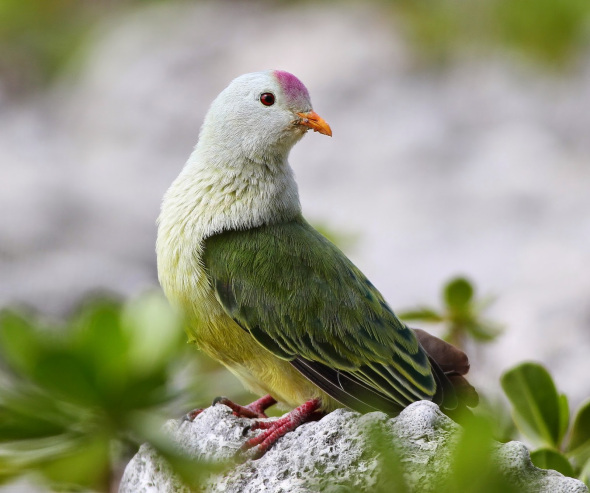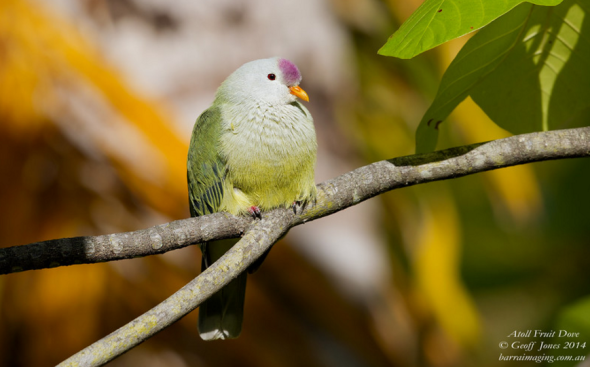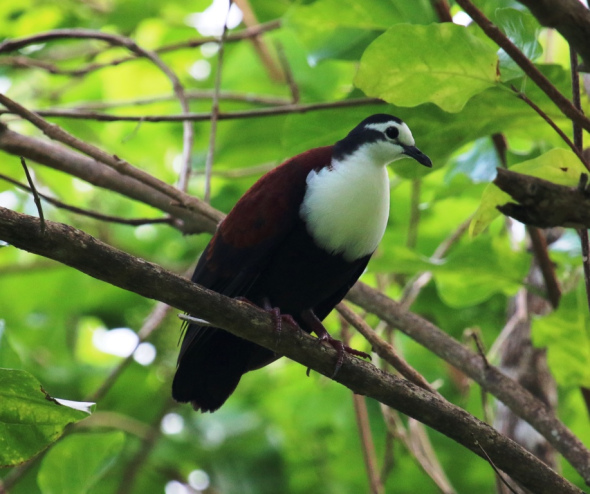
ENDANGERED SPECIES FRIDAY: PTILINOPUS CORALENSIS | ATOLL FRUIT DOVE
This Friday’s Endangered Species Post brushes up on a species of bird that many of you may never have heard of. The atoll fruit dove, that’s listed as (near threatened) is unfortunately nearing extinction within its endemic wild. Image: Atoll Fruit Dove, credits, Steve Smith.
Endemic to French Polynesia, the species was formally identified back in 1848 by Dr Titian Ramsay Peale (November 2, 1799 – March 13, 1885) who was an American artist, naturalist, entomologist, and photographer. He was the sixteenth child and youngest son of noted American naturalist Charles Willson Peale. He is sometimes referred to as Titian Ramsey Peale II to distinguish him from his older brother with the same name who was a favorite of their father and who died at age 18 in 1798.
From 1988 the atoll fruit dove was previously listed as lower risk/least concern, data from that period showed no reasonable justification for the bird to be listed as threatened due to the species being heavily populated throughout the French Polynesia islands. Unfortunately things have drastically changed since the the late 1980’s. French Polynesia is now home to many French and non-French citizens, all of which are gradually threatening the atoll fruit doves habitat - and many other animals too.
Data records prove that from the 1980’s right through to the new millennium the species did live a pretty undisturbed life. However come 2004 the atoll fruit doves habitat and their existence took a turn for the worse. From 2004-2016 the species was (re-listed as near threatened). Populations are still decreasing, and from what we are aware of to date, there has been no official records kept that can prove the current population size which we do find rather strange. French Polynesia isn’t exactly your largest island on the planet.
What does near threatened mean though? Below I’ve extracted a paragraph from the International Union for the Conservation of Nature that will help you understand more about this ‘category‘.
“A taxon is Near Threatened when it has been evaluated against the criteria but does not qualify for Critically Endangered, Endangered or Vulnerable now, but is close to qualifying for or is likely to qualify for a threatened category in the near future“
Scientifically identified as Ptilinopus coralensis, the species is widespread throughout the islands of the Tuamotu Archipelago, French Polynesia. It is likely to occur at low densities throughout its range as its preferred food resources are scarce. In a recent survey it was found to be uncommon on five out of eight islands visited, but others have found it to be abundant on some atolls which have remained free from the ravages of introduced predators.
Scientists haven’t as located any ‘sub-populations’, however have confirmed that there is a ‘continuous decline of mature individuals on the island examined’ however as yet we still don’t know to what extent other than a 30% drop in populations have been recorded.

Image: (Google Image Search): Atoll fruit dove (Credits: Geoff Jones 2014)
The atoll fruit dove is the world’s only dove in the tropical Pacific that has adapted exclusively to low coral atolls. It lives in forests and abandoned coconut plantations. It mainly feeds on insects and seeds, usually on the ground. This species also eats the leaves of the “tafano” or “kahaia” (Guettarda speciosa ) trees with odorous flowers.
THREATS
Predation by introduced rats (particularly black rat Rattus rattus) is a threat on a small number of atolls and the species is vulnerable to habitat destruction including the exploitation of coconut plantations. The species is also reported to be rather tame, and is rare on inhabited islands, so hunting may also be a threat.
Although the species is commonly known throughout the French Polynesian islands - there is still to date very little known about the bird. The issue with coconut plantation/exploitation has always been somewhat of a concern for myself and the team. In a sense its no different to be honest than the palm oil trade (however in this case, its coconut farming that is placing the species in danger to some extent!).
I am working with a number of conservationists on the French Polynesia islands that are keeping me updated on this issue overseas, as well as the cruel and barbaric dog and cat meat trade. For now our main priority is to ensure that we undertake a census in relation to the current atoll fruit dove population, examine the threats, and work how to minimize them threats (Etc).. ..Unfortunately though I cannot provide any further up to date information relating to this bird and whether the specie will be extinct soon.
Dr Jose Carlos Depre: PhD. MEnvSc. BSc(Hons) Botany, PhD(NeuroSci) D.V.M
Master of Environmental, Botanical & Human Science.
Chief Environmental Officer and CEO.
September 2, 2016 | Categories: You must be the change you want to see in the world | Tags: Atoll, Atoll Dove, Atoll Fruit Dove, Atolls. Dove, Birds, Coconut Exploitation, Doves, Dr Titian Ramsay Peale, Environment, French Polynesia, Geoff Jones, nature, Ptilinopus coralensis, South East Pacific, Steve Smith Photographer, Wildlife | Leave a comment

Endangered Species Friday: Alopecoenas kubaryi
This Fridays Endangered Species watch Post (ESP), I document on the Caroline Ground Dove scientifically identified as Alopecoenas kubaryi. The species was discovered and named back in 1880 by explorer Friedrich Hermann Otto Finsch (8 August 1839 - 31 January 1917, Braunschweig) was a German ethnographer, naturalist and colonial explorer. Since new data has emerged in relation to the species that Hermann identified, the bird has since been correctly renamed and placed into the correct specie table (please read more below). (Image: Alopecoenas kubaryi: Author unknown).
Listed as vulnerable populations are continuing to decline, and with such a small population size its quite likely this rather beautiful and peaceful little bird will soon meet the criteria for endangered listing on the threatened species list very soon.
Endemic to Micronesia there are no fewer than 250-999 ‘mature individuals’ remaining if that, (that’s incredibly depressed for a bird listed as vulnerable). This sadly equates to exactly 375-1500 individuals in total. In theory I’m perplexed as to why this beautiful bird hasn’t been re-categorized as critically endangered. Should the wild population continue to decrease at the rate it currently is there will be no time left to re-list this bird or, implement much stronger and professional conservation efforts that are already seen today.
As explained the species is native to the Federated States of Micronesia which is an independent sovereign island nation and a United States associated state consisting of four states – from west to east, Yap, Chuuk, Pohnpei and Kosrae which are situated and spread across the Pacific ocean. The Caroline Ground Dove (common name) is located mostly within the Pohnpei region.
From 1983-1984 within the Pohnpei region populations were said to be as high as 841 mature individuals. That would have equated back then to roughly just over 3,000 individuals in total. Back in 1994 another census was undertaken in relation to the species current population trend within the birds stronghold of Pohnpei.
Unfortunately the survey recorded a staggering decrease in overall population rates within the lowlands. Meanwhile back in 2001 a further survey was conducted which again showed a dramatic decline in population trends. A conservationist by the name of Dr Baker ‘alleged’ in 1951 that the Caroline Ground Dove populations have always been depressed.
I personally disagree with this statement and if populations were ‘surveyed’ to be declining then why wasn’t extreme conservation measures implemented back then to protect the species stronghold and establish a type of nature reserve to increase population sizes? Furthermore and as I have explained why hasn’t the species been listed as (critically endangered?). The evidence is more than clear that populations rather than being (small) have in fact (declined). Conservation efforts that are currently underway too are in my opinion way to late.
The Caroline Ground Dove is commonly known by the locals as; Caroline Ground-dove; Caroline Islands Ground-Dove or the White-fronted Ground Dove. Caroline Ground Dove’s scientific identification back in the 1880’s was put into the wrong (specie) listing commonly known as Gallicolumba kubaryi. However the bird has since been entered into the correct specie list, now known as Alopecoenas kubaryi. The genera remains the same.
Caroline Ground Doves are known to inhabit tropical or sub-tropical rain-forest of which their preferred habitat is normally within Hibiscus trees. The dove takes a preferential liking to the specie of Hibiscus known scientifically as Hibiscus tiliaceus. Unfortunately the areas from which the bird specie resides is normally within and/or around human settlements which sadly poses a direct threat to the bird due to habitat destruction from human settlements. The dove can also be located in lowland, mangrove and montane rain-forests too.
In the region of Chuuk the Caroline Ground Dove is normally seen inhabiting agricultural areas (again this can pose a significantly high threat) to the bird in general. Reports have also stated that some small populations were located on islets which would indicate coastal habitat is also preferred by the Caroline Ground Dove. Within the region of Weno where habitat is said to be degraded spotters have confirmed the bird may also prefer degraded habitat too.
Diet normally consists of seeds, worms, snails and insects. A. kubaryi normally nests in dense forest at around 180 meters inland. Within the Chuuk province conservationists have confirmed that nests with eggs in have been surveyed from the months of; February, April, June and September. So we know the species normally mates and nests all year round. However unlike other doves that normally lay in the region of 1-3 eggs within a clutch, the Caroline Ground Dove is only known to produce one egg per clutch. Again I question why the species hasn’t been listed as (critically endangered). How much evidence does one need?

Image: Alopecoenas kubaryi
Threats
On Pohnpei, predation by introduced species (mainly rats Rattus spp. and cats) and excessive hunting may have caused some depletion. Habitat loss is also a major issue. Overall, there was a reduction of undisturbed upland forest on Pohnpei of over 60% from 1975-1995.
The majority of the island’s forests have been, to varying degrees, converted or at least degraded to mixed forest (native species mixed with lowland secondary species), largely attributable to the cultivation of sakau (kava) Piper methysticum as a major cash-crop. The fragmentation of such forest by sakau clearings also introduces and encourages the spread of invasive species in isolated areas throughout the forest.
Although efforts over the past 20 years to reduce the amount of clear-cutting for sakau plantations have resulted in the slowing of native forest conversion rates, the trend remains negative. On Chuuk, the only remaining semi-original forest remains in tiny remnants on the higher reaches of a few islands.
Traditional leaders have been encouraged to adopt a programme to plant sakau in the lowlands, but resistance is high because the plant grows best on wet mountain slopes and is less likely to be pilfered in more remote areas. Watershed Forest Reserve boundary lines have been laid down and enforced in Madolenihmw and Uh on Pohnpei.
Proposed conservation actions (already now underway) and past conservation actions are in my expert opinion not good enough nor will they prevent this bird from going extinct within five years to seven years max. I do find it somewhat odd that the United States Fish and Wildlife Service haven’t steeped in here to increase more help. But then these islands really are not run by the United States Government. I personally believe the specie will be extinct in five years. Sadly not enough is being done to preserve this stunningly beautiful dove.
Thank you for reading.
Dr Jose Carlos Depre.
Environmental and Botanical Scientist.
[email protected]
For more information follow us on Facebook.
August 14, 2015 | Categories: You must be the change you want to see in the world | Tags: (ESP), Alopecoenas kubaryi, Animals, Baker, Bird, Birds, Caroline Ground Dove, cats, Chuuk, Conservation, critically endangered, Dove, Doves, Dr Depre, Endangered species, Federated States of Micronesia, Felines, Friday, Fridays Animal, Gallicolumba kubaryi, Hibiscus tiliaceus, IARF, International Animal Rescue Foundation Africa, Invasive species, J.C Depre, Jose Depre, Kosrae, Micronesia, Pacific ocean, Pohnpei, Rain Forest, Rats, Rattus spp, United States, USA, Wild Birds, Wildlife, Yap | Leave a comment






